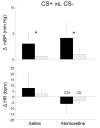Atomoxetine changes rat's HR response to stress from tachycardia to bradycardia via alterations in autonomic function
- PMID: 20018569
- PMCID: PMC2844913
- DOI: 10.1016/j.autneu.2009.11.003
Atomoxetine changes rat's HR response to stress from tachycardia to bradycardia via alterations in autonomic function
Abstract
Atomoxetine is a central norepinephrine reuptake inhibitor used to treat attention deficit hyperactivity disorder. We tested the effects of atomoxetine upon the heart rate (HR) and mean arterial blood pressure (mBP) response to aversive conditioning. In Protocol 1 the mBP and HR responses to a stress (15s tone followed by shock) were tested in 8 Sprague-Dawley rats given saline pretreatment for 3 days; the rats' responses were then tested for 3 additional days following atomoxetine (1mg/kg, sc). Atomoxetine decreased (p<0.05) baseline mBP from 128+/-11 mm Hg (mean+/-SD) to 117+/-19 mm Hg; baseline HR slowed from 380+/-23 bpm to 351+/-21 bpm. The mBP increase to acute stress was similar after saline vs. after drug, but the peak was attained more slowly. After atomoxetine HR tended to slow during stress rather than accelerate. In Protocol 2 the cardiovascular responses were tested (n=6) for 3 days post-saline and for 3 days after a higher dose of atomoxetine (2mg/kg, sc). The average HR acceleration during the last 10s of the stress after saline (+7.5+/-14.7 bpm) was replaced by a HR slowing (-6.2+/-10.5 bpm). We conclude that drug treatment (a) decreases baseline sympathetic tone and/or elevates cardiac parasympathetic tone; (b) slows sympathetic arousal to acute stress without changing its magnitude; and, (c) enables the emergence of elevated parasympathetic tone during the stress. These autonomic consequences are consistent with atomoxetine's anxiolytic and transient sedative effects.
2009 Elsevier B.V. All rights reserved.
Figures





Similar articles
-
Chronic angiotensin-II treatment potentiates HR slowing in Sprague-Dawley rat during acute behavioral stress.Auton Neurosci. 2013 Mar;174(1-2):42-6. doi: 10.1016/j.autneu.2012.12.004. Epub 2013 Jan 11. Auton Neurosci. 2013. PMID: 23317537 Free PMC article.
-
Effects of norepinephrine reuptake inhibition on postural tachycardia syndrome.J Am Heart Assoc. 2013 Sep 3;2(5):e000395. doi: 10.1161/JAHA.113.000395. J Am Heart Assoc. 2013. PMID: 24002370 Free PMC article. Clinical Trial.
-
Atomoxetine affects transcription/translation of the NMDA receptor and the norepinephrine transporter in the rat brain--an in vivo study.Drug Des Devel Ther. 2013 Dec 4;7:1433-46. doi: 10.2147/DDDT.S50448. eCollection 2013. Drug Des Devel Ther. 2013. PMID: 24348020 Free PMC article.
-
Atomoxetine--treatment of attention deficit hyperactivity disorder: beyond stimulants.Drugs Today (Barc). 2004 May;40(5):465-73. doi: 10.1358/dot.2004.40.5.850493. Drugs Today (Barc). 2004. PMID: 15319800 Review.
-
Spotlight on atomoxetine in adults with attention-deficit hyperactivity disorder.CNS Drugs. 2004;18(6):397-401. doi: 10.2165/00023210-200418060-00011. CNS Drugs. 2004. PMID: 15089111 Review.
Cited by
-
Atomoxetine Augmentation in a Case of Treatment Resistant Panic Disorder with Multiple Augments Failure: A Case Report.Clin Psychopharmacol Neurosci. 2015 Dec 31;13(3):321-3. doi: 10.9758/cpn.2015.13.3.321. Clin Psychopharmacol Neurosci. 2015. PMID: 26598594 Free PMC article.
-
Acute tryptophan depletion attenuates conscious appraisal of social emotional signals in healthy female volunteers.Psychopharmacology (Berl). 2011 Feb;213(2-3):603-13. doi: 10.1007/s00213-010-1897-5. Epub 2010 Jul 2. Psychopharmacology (Berl). 2011. PMID: 20596858 Free PMC article. Clinical Trial.
-
Diurnal variations in arousal: a naturalistic heart rate study in children with ADHD.Eur Child Adolesc Psychiatry. 2011 Aug;20(8):381-92. doi: 10.1007/s00787-011-0188-y. Epub 2011 May 29. Eur Child Adolesc Psychiatry. 2011. PMID: 21626226
-
The effect of atomoxetine, a selective norepinephrine reuptake inhibitor, on respiratory arrest and cardiorespiratory function in the DBA/1 mouse model of SUDEP.Epilepsy Res. 2017 Nov;137:139-144. doi: 10.1016/j.eplepsyres.2017.08.005. Epub 2017 Aug 24. Epilepsy Res. 2017. PMID: 28844345 Free PMC article.
-
Atomoxetine-induced life-threatening long QT syndrome.Ir J Med Sci. 2013 Sep;182(3):535-7. doi: 10.1007/s11845-013-0925-y. Epub 2013 Feb 19. Ir J Med Sci. 2013. PMID: 23420381 No abstract available.
References
-
- American Physiological Society Guiding principles for research involving animals and human beings. Am J Physiol Regul Integr Comp Physiol. 2002;283:R281–R283. - PubMed
-
- American Psychiatric Association . Diagnostic and Statistical Manual of Mental Disorders. 4th Ed American Psychiatric Association; Washington, DC: 2000.
-
- Brown DR, Li S-G, Lawler JE, Randall DC. Sympathetic control of BP and BP variability in borderline hypertensive rats on high- vs. low-salt diet. Am J Physiol Regul Integr Comp Physiol. 1999;277:R650–R657. - PubMed
-
- Burgess DE, Hundley JC, L,i S, Randall DC, Brown DR. Multifiber renal sympathetic nerve activity recordings predict mean arterial blood pressure in unanesthetized rat. Am J Physiol Regul Integr Comp Physiol. 1997;273:R851–R857. - PubMed
Publication types
MeSH terms
Substances
Grants and funding
LinkOut - more resources
Full Text Sources
Miscellaneous

